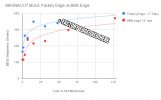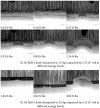If I understand you, you're defining durability as the ability to survive impact, yes? That makes intuitive sense to me, and of course Larrin confirmed it in the experiments you posted. I wonder if the results would be the same with respect to impacting something like a cutting board, as opposed to something most folks are less likely to encounter, like a brass rod? One way to find out I guess.

No, it's not just impact.
If the lower angle edge accidentally makes contact with something "not cuttable" like a rock on the ground or a metal staple in cardboard, It will be more susceptible to taking edge damage through deformation or chipping than if it was at a thicker angle (If all the variables are accounted for)
This is an important concept to understand for fine-tuning the edge angle for a given user's preference or how they intend to use it.
It's one of the reasons why there is no universal edge angle, it just depends on the person using it what their preferences are, what they use it for, how careful they are with their edge or conversely how careless they are for their edge.
A lot of good professional knife sharpeners do this intuitively with their sharpening work for customers. When they receive a customer's knife that shows significant damage they will increase the edge angle to a thicker angle. Without surprise, the customer is pleasantly happy with this new thicker angle for how they use it.
On the other hand, if the customer's edge looks like it's been worn smoothly with little to no damage than that customer may benefit from a lower edge angle since the primary mode of of edge retention loss was through actual cutting not by misuse.
So, a good sharpener matches the edge angle to the failure mode. So again, there is no universal edge angle.
In conclusion, it is an inverse relationship between cutting ability/cutting edge retention and durability/toughness.
We get more cutting edge retention with lower edge angles at a cost to the toughness of the edge.
To wrap it up, if we want more cutting edge retention we have to use it more judiciously and be conscious of what our edges are making contact with.
Most folks seem to have amnesia when it comes to remembering what their edge may have had contact with to cause the damage that mysteriously appeared as a chip.
If we want maximum durability we need a thicker edge yet, then the punishment will be the cutting ability and cutting edge retention gets obliterated.
However that kind of user isn't really cutting things anyways as much as they are bludgeoning things, so, they are happy as long as it doesn't chip.
In the end, I'm not going to make a knife at 13° per side and give it to somebody who is going to use it to breach a car door and dig a hole in the ground followed by using it as a throwing knife in his backyard. I'd give him a 90° per side edge

We match edge angles to the failure mode and the end user is the greatest variable of all






